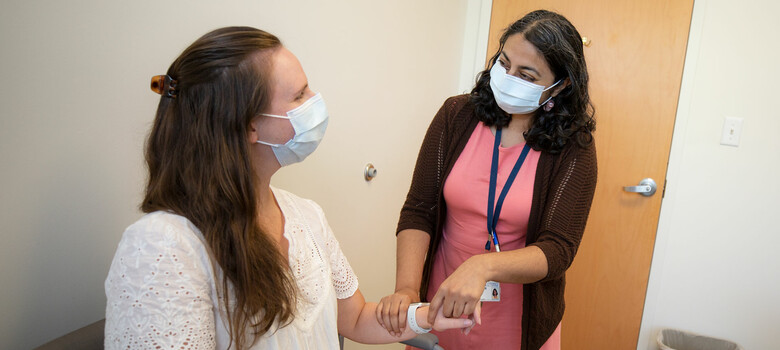What You Need to Know About Deep Brain Stimulation for Movement Disorders
Implanted Device Can Reduce Seizures and Tremors

A deep brain stimulator uses electrodes placed into central parts of the brain, which deliver electrical impulses to reduce symptoms like seizures and muscle spasms.
Deep brain stimulation (DBS) is a surgical therapy for movement disorders like Parkinson’s disease and essential tremor. Electrodes are placed into central parts of the brain and deliver electrical impulses to reduce symptoms like muscle spasms. If other treatments aren’t controlling your symptoms, you may want to consider deep brain stimulation. Here, Stephen Harward, MD, a Duke Health neurosurgeon specializing in DBS, answers frequently asked questions to help you decide.
What is Deep Brain Stimulation?
Deep brain stimulation is a type of neuromodulation treatment that uses electrical stimulation to reduce harmful brain or nerve activity.
How Does Deep Brain Stimulation Work?
Two electrodes, each about the size of a toothpick, are surgically placed in your brain. They send out electrical pulses to interrupt the brain signals responsible for your symptoms. The electrodes are powered by a small battery pack that sits under the skin in your chest. Once placed, a neurologist wirelessly activates your DBS system and adjusts its settings to maximize benefit.
“I liken DBS to a TENS unit, or transcutaneous electrical nerve stimulation, which delivers electrical impulses through the skin to treat chronic pain,” Dr. Harward said. “DBS uses the same basic principle of applying electrical stimulation to scramble unwanted nervous system signals.”
Like her father, Mary Smith has experienced essential tremors for decades. In early 2024, the Wake Forest, NC resident underwent surgery at Duke Raleigh Hospital, a campus of Duke University Hospital, to receive a deep brain stimulation implant. Watch Smith's journey as her tremors are greatly reduced, making everyday tasks like cooking, writing, and eating much easier.
Does Deep Brain Stimulation Require Brain Surgery?
Yes. DBS surgery is a two-step process. During step one, a neurosurgeon makes two small holes in your skull and places electrodes into deep targets within your brain.
A few weeks later, a second, less-invasive surgery is performed to place the battery pack near your collarbone and connect it to the electrodes via threadlike wires.
Am I a Good Candidate for Deep Brain Stimulation?
- Essential tremor and dystonia candidates: You may be a candidate for DBS if you experience tremors of the head, voice, or especially the hands or arms that significantly hinder your ability to complete everyday tasks (like dressing, eating, and drinking) and don’t respond well to medications.
- Parkinson’s disease candidates: You may be a candidate for DBS if you respond well to certain medications, specifically Sinemet. However, Dr. Harward stressed that DBS only treats Parkinson’s symptoms that involve motor function, the most common of which are tremors, bradykinesia or slowness of movement, and stiffness. Other common Parkinson’s symptoms like memory loss do not respond to DBS.
DBS is not recommended if you experience cognitive issues or dementia because it may worsen these problems.
When Can I Expect a Benefit? How Much? For How Long?
Many people experience instant improvement in symptoms when their device is activated. This usually takes place about two weeks after the surgical procedure to place the battery. “It's one of the few things in medicine where we get to see an immediate impact,” Dr. Harward said. Others may not experience a benefit for weeks or months.
People with essential tremor or Parkinson’s disease typically experience 70% to 80% improvement in their symptoms, according to Dr. Harward. The benefits usually last at least five years, with many people experiencing a benefit for 10 years or more, he said.
What Complications Are Associated with Deep Brain Stimulation?
Because DBS requires surgery, there is a small risk of bleeding, infection, coma, stroke, or death. The most common side effects of electrical stimulation include tingling, numbness, muscle weakness or muscle contractions, difficulty speaking, eye movement abnormalities, or vision changes. Often these improve by adjusting the DBS device settings.
Are There Activity Restrictions?
“After you recover from surgery, you can do anything you want, from traveling to swimming to riding roller coasters.” Dr. Harward said.
Will It Be Obvious to Others?
No, most people won’t be able to tell you have a DBS device. The surgical incision on your head will be hidden beneath your hair. There will be a small scar on your chest where the battery pack was placed.
Why Should I Choose Duke for Deep Brain Stimulation?
Duke has offered DBS for nearly 30 years, so our clinical teams have a lot of experience in how to do it safely and effectively, said Dr. Harward. Duke researchers have also been studying and improving this technology for decades. As a result, Duke provides the most up-to-date and advanced techniques and approaches.
Duke experts take a personalized approach to DBS therapy to maximize benefits while minimizing side effects. Plus, the Duke team offers “awake” and “asleep” surgery, meaning you can choose the type of anesthesia you are most comfortable with. Consultation, surgery, and follow-up care are available at Duke clinics and hospitals in Durham and Raleigh.
“Duke offers everything you need to be evaluated for DBS therapy, to receive the therapy, and to follow up over time so you get the most benefit from the device,” Dr. Harward said.
What Is My Next Step?
Talk to your neurologist, as it’s never too early to start the conversation. This is true even if your symptoms are still mild, Dr. Harward said. “Talking about these treatment options, even years before you might be ready for them, can be very empowering.”




